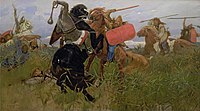Druzhina

| Part of a series on |
| Imperial, royal, noble, gentry and chivalric ranks in Europe |
|---|
 |
In the medieval history of Kievan Rus' and Early Poland, a druzhina, drużyna, or družyna (Slovak and Czech: družina; Polish: drużyna; Russian: дружина, romanized: druzhina; Ukrainian: дружи́на, druzhýna literally a "fellowship") was a retinue in service of a Slavic chieftain, also called knyaz. The name is derived from the Slavic word drug (друг) with the meaning of "companion, friend".[1][2]
 |
| Knyaz (sovereign) |
| Boyar / Szlachta (noble) |
| Druzhinnik (retainer) |
| Smerd (free tenant) |
| Kholop (slave) |
Early Rus'
[edit]In the Rus' Khaganate, a druzhina helped the prince administer his principality and constituted the area's military force. The first members of a druzhina were the Varangians,[3] whose princes established control there in the 9th century.[4] Soon, members of the local Slavic aristocracy and adventurers of a variety of other nationalities became druzhinniki. The druzhina's organization varied with time and survived in one form or another until the 16th century.[5]
The druzhina was composed of two groups: the senior members, later known as boyars, and the junior members, later known as boyar scions. The boyars were the prince's closest advisers and performed higher state functions. The junior members constituted the prince's personal bodyguard and were common soldiers. Members were dependent upon their prince for financial support but served the prince freely and had the right to leave him and join the druzhina of another prince.[citation needed]
As a result, a prince was inclined to seek the goodwill of his druzhina by paying the druzhinniki wages, sharing his war booty and taxes with them and eventually rewarding the boyars with landed estates that were complete with rights to tax and administer justice to the local population.[citation needed]
At the Battle on the Ice, the army of the Novgorod Republic had about 5000 men in all. Around 3000 men in both the cavalry and the infantry were part of Alexander Nevsky's druzhina.[citation needed]
Poland
[edit]Ibrahim ibn Yaqub, who traveled in 961–62 in Central Europe, mentions that the drużyna of Duke Mieszko I of Poland had 3000 men, paid by the duke.[6] Unlike his predecessors, Casimir I the Restorer promoted landed gentry over the drużyna as his base of power.[citation needed]
See also
[edit]- Housecarl
- Leidang
- Hird
- Voluntary People's Druzhina, a civilian organization in the Soviet Union
- Czechoslovak Legion First unit in Russia, called the "Czech Companions" (Česká družina or Družina)
- Wenceslaus I, Duke of Bohemia murdered by Boleslav's companion
References
[edit]- ^ "Online Etymology Dictionary". www.etymonline.com. Retrieved 13 May 2017.
- ^ Zeno. "Drushine". www.zeno.org. Retrieved 13 May 2017.
- ^ "druzhina - Russian history". Retrieved 13 May 2017.
- ^ "Kievan Rus - historical state". Retrieved 13 May 2017.
- ^ "Druzhina". Retrieved 13 May 2017 – via The Free Dictionary.
- ^ "Ibrāhīm ibn Ya‛qūb al-Isrā’īlī al-Ṭurṭūshī," by Lutz Richter-Bernburg, in: The Oxford Companion to World Exploration, David Buisseret, editor-in-chief, 2 vols., Oxford UP 2007, I:402b-403b
Bibliography
[edit]This article incorporates text from a publication now in the public domain: . Brockhaus and Efron Encyclopedic Dictionary (in Russian). 1906.
External links
[edit]![]() Media related to Druzhina at Wikimedia Commons
Media related to Druzhina at Wikimedia Commons

